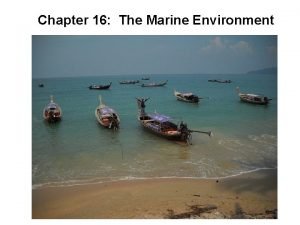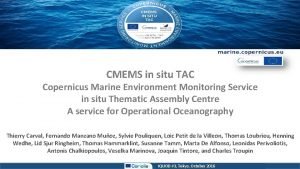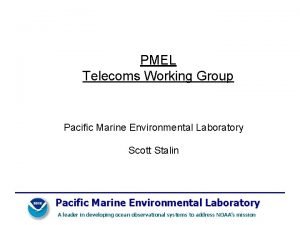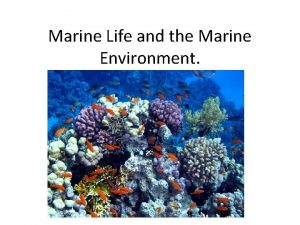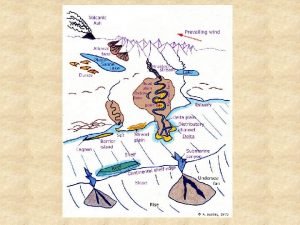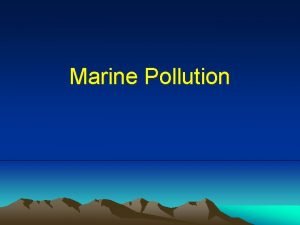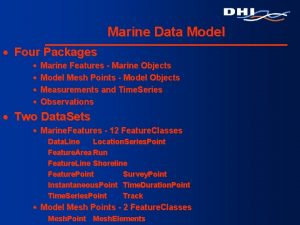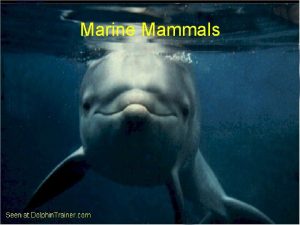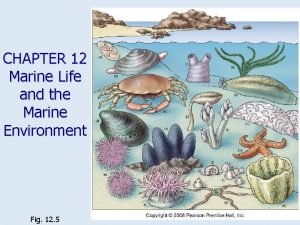Environmental Factors Environmental factors in the marine environment



















- Slides: 19

Environmental Factors Environmental factors in the marine environment: temperature, salinity, pressure, nutrients, dissolved gases, currents, light, suspended sediments, substrate (bottom material), river inflow, tides and waves. § Ecosystem is the total environment including the biota (all § § § living organisms) and non-living physical and chemical aspects. A self-sustaining system. Temperature can control distribution, degree of activity and reproduction of an organism. Salinity can control the distribution of organisms and force them to migrate in response to changes in salinity. Hydrostatic pressure is the pressures exerted by a column of water surrounding an organism.

Things to know about temperature effects in the ocean: • Marine organisms have an advantage over terrestrial organisms in that temperature variation is moderated by the high heat capacity of water. That is, for most of the ocean temperatures don’t get below freezing or above 40°C (about 100°F). • Having said this it is still true that temperature has big effects, especially for “coldblooded” organisms which make up most of the life in the ocean. Exceptions are the “warm-blooded” marine mammals (e. g. whales, porpoises) and birds (e. g. penguins). • The metabolic rate of cold-blooded organisms doubles with each temperature increase of 10°C. As their body temperatures increase they need more O 2 and more food. But as you remember from chemistry (? ? ), the warmer the water the less gas (including O 2) will dissolve in it. So the warmer the water gets the more O 2 the organism needs but the less O 2 is available. So some fish can literally suffocate in warm water. (Note only organisms that use gills to extract dissolved O 2 are affected. This doesn’t apply to air-breathers like whales, penguins, marine reptiles which have lungs. ) • Here’s another very important point: The atmosphere is rich in O 2 and poor in CO 2 (390 ppm is really not that much), but the opposite is true in the ocean. Because of chemical effects we didn’t discuss, the ocean is poor in dissolved O 2 and rich in dissolved CO 2. So it is possible for large parts of the ocean to get depleted in O 2. These are called “dead zones” where fish and other organisms can’t survive.

Metabolic rate doubles with every 10°C increase, but warm water can’t hold as much dissolved O 2. Therefore many organisms can not tolerate warm enclosed bays or estuaries.

Some things to know about salinity: Most organisms have strict salinity tolerances. In the open oceans salinity varies little, but in coastal areas such as estuaries salinity can vary widely. The latter habitat has low diversity (i. e. few species live there). Even where salinity is stable, organisms have to make special adaptations to control their internal salinities. Diffusion: substances dissolved in water tend to move from where they have a large concentration to where they have a low concentration until the overall concentration is uniform. For example if you put sugar in a cup of coffee and wait long enough you don’t have to stir the coffee; the sugar will dissolve and spread through the cup.

Osmosis: The diffusion of water across a membrane like a cell membrane. • The problem of fish (and marine vertebrates in general) in salt water. • Fish have an internal salinity of 10 -15 o/oo but sea water has a salinity of 35 o/oo • Therefore the fish tends to dehydrate because water has a higher concentration inside the fish than outside and water diffuses out. Salt tends to diffuse into the fish. • To fight the dehydration fish have special salt cells in their gills that excrete excess salt out of their bodies and special kidneys that excrete very salty, low-water content urine. The get rid of the salt and hold on to their water. • So they are forcing salt out of their bodies against the concentration gradient and against the natural tendency of diffusion. This is called active transport.

The problem with fresh-water fish: • Again the fish have an internal salinity of 10 -15 o/oo and fresh water is almost 0 o/oo (Natural fresh water is not absolutely pure. ) • Therefore the fish have a tendency to take on too much water because their bodies have a lower concentration of H 2 O than the surrounding fresh water. Also salt tends to diffuse out of their bodies. • To fight the intake of H 2 O and the loss of salt, fresh water fish have “salt cells” in their gills that work the opposite way and extract what ever salt is in the fresh water and kidneys that produce a lot of lowsalt, water-rich urine. They get rid of their water and hold onto their salt. • So once again their bodies are working against the concentration gradients and the natural tendency of diffusion. This is another example of active transport.

Marine organisms – Drink large amounts of water – Chloride cells extract and dispose of excess salt • Freshwater organisms – Don’t drink – Produce large amounts of dilute urine The process of maintaining the proper salinity for their bodies is called osmoregulation.

• Now invertebrates (organisms without backbones like clams, coral, crabs, starfish) have internal salinities more like sea water and don’t have the adaptations for osmoregulation that fish have. • Few fish can live in environments with changing salinities like estuaries and salt marshes or migrate like salmon from fresh to salt water. So shoreline habitats even though they may have abundant life commonly have low diversity. That is, the number of species is small. • This is an important general principle: habitats with widely varying physical conditions (e. g. temperature, salinity, dissolved O 2 content) have low diversity.

Pressure Effects on Organisms Pressure increases 1 atm per 10 meters of water column § Nitrogen narcosis: Divers can get this if they dive too deep with regular air in their tanks. Regular air is 78% nitrogen. Remember more gas can dissolve in liquids (like blood) under pressure. Nitrogen in high concentrations is a narcotic. So at depth too much nitrogen will dissolve into the blood. Divers may drown when they become confused, disoriented or even black out. So special gas mixtures without nitrogen must be used by deep divers. § Decompression sickness: “the bends” – This occurs when deep divers return to the surface too quickly. The extra gas that dissolved in their blood under pressure bubbles out (like opening champagne). The bubbles can block capillaries causing pain and even death. § Now, for example, a sperm whale comes to the surface to breath air and then dives as deep as half a mile to prey upon squid. After half an hour it rushes to the surface to breath. The whale must have special adaptations to avoid nitrogen narcosis and decompression sickness.

Adaptive mechanisms Gas bladder - Fish control their buoyancy and in order to rise or sink in the water column. Also called air bladder or swim bladder Sharks and rays: Large oily liver, light skeleton, pectoral fins for stability; Advantages: rapid changes in depth possible Bony fish: Gas-filled swim bladder, pectoral fins freed for other uses - great diversity of forms

Selective Adaptive Strategies - Size is the single most important characteristic affecting the ecology of phytoplankton Advantages to being small (microscopic): -Slow settling rates -High frictional drag (directly related to the surface area-to-volume ratio) • To photosynthesize (produce organic material from • inorganic matter and sunlight) autotrophs must remain within the photic zone. So being microscopic means phytoplankton won’t settle out of the sunlight. • More than 90% of marine photosynthesizers are algae and most are microscopic.

Selective Adaptive Strategies, cont’d The morphology of fish has evolved to allow them to move through the water easily. § The fish’s body must overcome three types of drag (resistance): Surface drag, Form drag, and Turbulent drag. § Speed is dependent upon body length, beat frequency, and the aspect ratio of the caudal fin. § There is a strong correlation between predation success and body form. § Bottom line: fish have to be streamline to swim quickly.

Selective Adaptive Strategies: Camouflage The fish is in all three pictures!

Another extremely important factor is light penetration into the ocean. • The upper part of the ocean illuminated by enough sunlight to allow photosynthesis is called the photic zone. • The part to the ocean too deep to be illuminated by sunlight is called the aphotic zone. The graph in the next slide deals with the photic zone. • The dashed line shows how the intensity of sunlight decreases with depth. • You might expect that the photosynthesis rate (solid line) of the phytoplankton would parallel the sunlight curve, but it doesn’t. • The photosynthesis rate in the upper 20% of the photic zone is less. Phytoplankton, like us, can get damaged by the Sun’s ultraviolet light, but water acts as a sunscreen. So it takes the upper part of the photic zone to block it.


Now to deal with the compensation depth. Now photosynthesizers, like phytoplankton and plants, take in CO 2, keep the C for growth, and release O 2 into the air or water. Animals respire, that is, they take in O 2 to oxidize their food and release CO 2 into the air or water. So respiration is, in one sense, the opposite of photosynthesis. But phytoplankton and plants also respire. They use up some of the O 2 they produced in photosynthesis.

• Now in the next graph the photosynthesis rate curve is the same as in the previous graph. • The vertical curve is the respiration rate of the phytoplankton. Now even in the dark the phytoplankton has to respire, so respiration is constant with depth. • At about 70 meters down the two curves cross. Above that point the photosynthesis rate is greater than the respiration rate; the phytoplankton produce more O 2 than they need for respiration. The extra O 2 is released into the ocean. This becomes available for all the animals. • Below 70 meters the respiration rate of the phytoplankton is greater than the photosynthesis rate. The phytoplankton need more O 2 for respiration than they produce from photosynthesis. They have to absorb it from the water just as the animals do.

• The cross-over point is the compensation depth. • Above that is the euphotic zone: the upper part of the photic zone where extra O 2 is produced. • That 70 meter thick euphotic zone supplies the entire ocean with O 2 through thermohaline circulation. That 70 meters is just an average, it can vary with the angle of incidence of sunlight and how murky the water is from sediment, etc.

 Chapter 16 the marine environment
Chapter 16 the marine environment Copernicus marine environment monitoring service
Copernicus marine environment monitoring service Pacific marine environmental laboratory
Pacific marine environmental laboratory 3 p's of environmental awareness
3 p's of environmental awareness Financial environment in business environment
Financial environment in business environment Mh 605
Mh 605 Hình ảnh bộ gõ cơ thể búng tay
Hình ảnh bộ gõ cơ thể búng tay Bổ thể
Bổ thể Tỉ lệ cơ thể trẻ em
Tỉ lệ cơ thể trẻ em Gấu đi như thế nào
Gấu đi như thế nào Chụp phim tư thế worms-breton
Chụp phim tư thế worms-breton Hát lên người ơi
Hát lên người ơi Môn thể thao bắt đầu bằng từ đua
Môn thể thao bắt đầu bằng từ đua Thế nào là hệ số cao nhất
Thế nào là hệ số cao nhất Các châu lục và đại dương trên thế giới
Các châu lục và đại dương trên thế giới Công thức tiính động năng
Công thức tiính động năng Trời xanh đây là của chúng ta thể thơ
Trời xanh đây là của chúng ta thể thơ Mật thư tọa độ 5x5
Mật thư tọa độ 5x5 101012 bằng
101012 bằng
